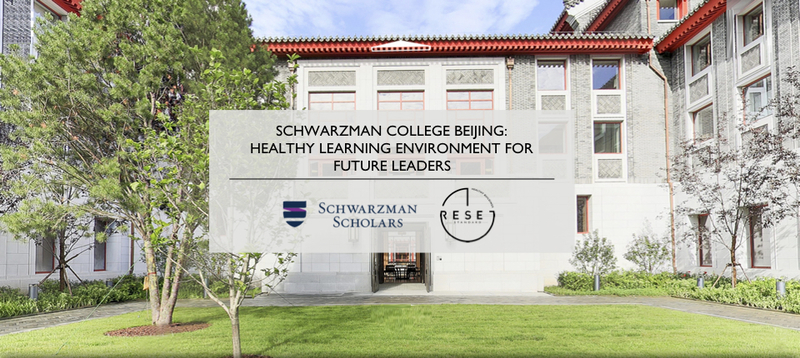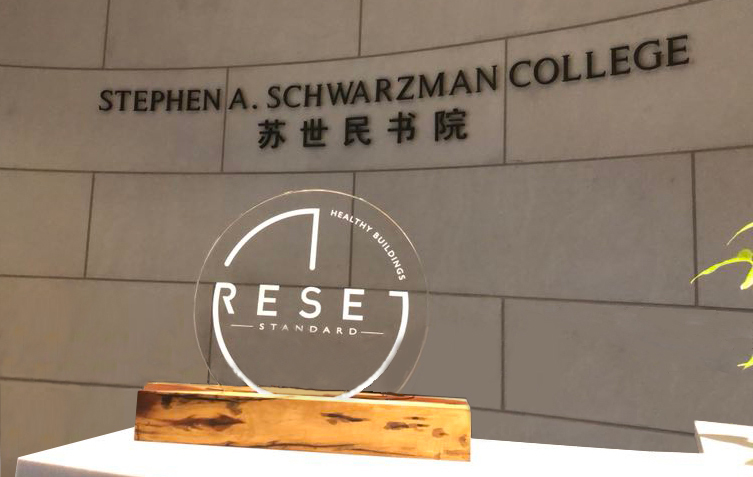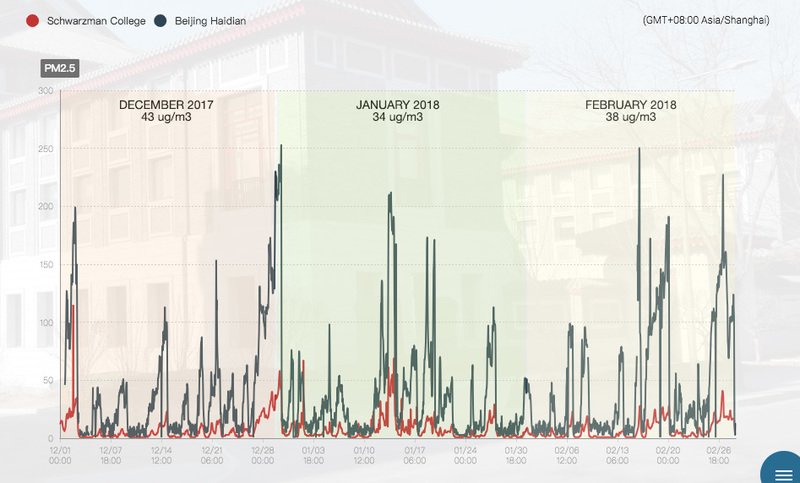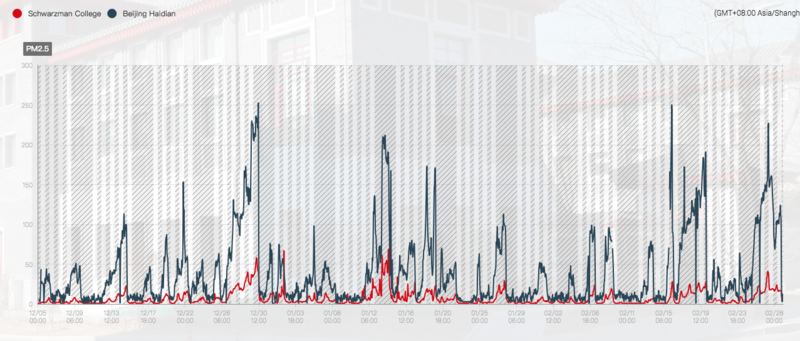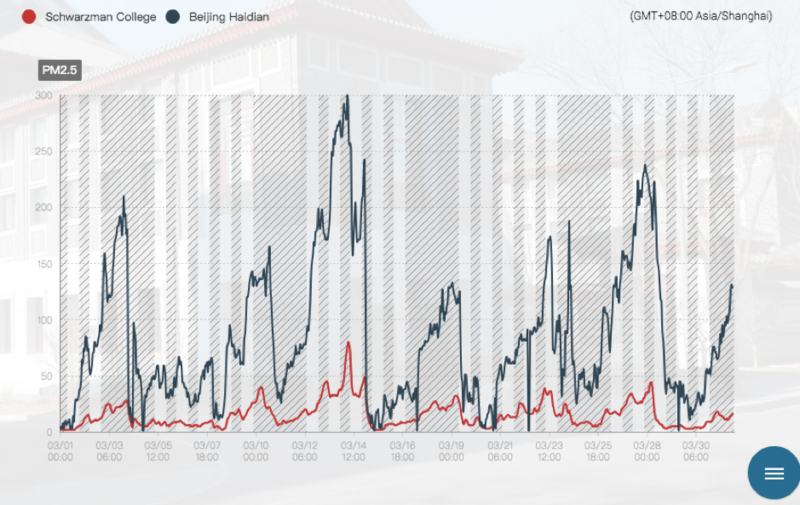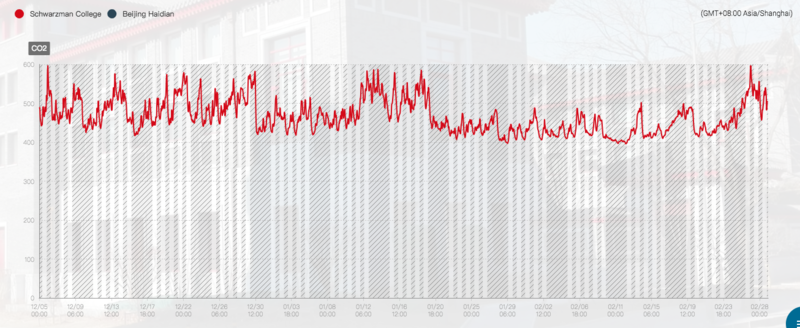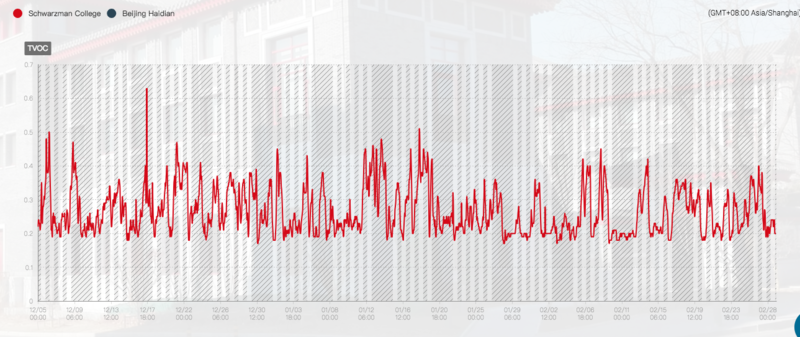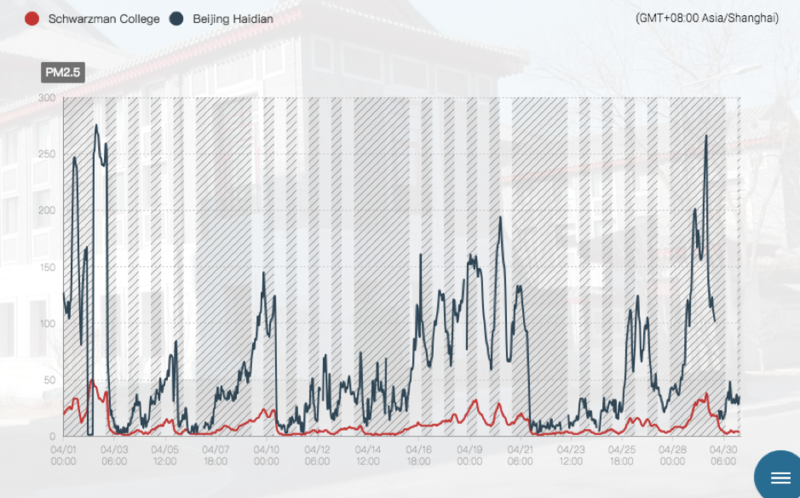Schwarzman College Beijing: Healthy Learning Environment for Future Leaders
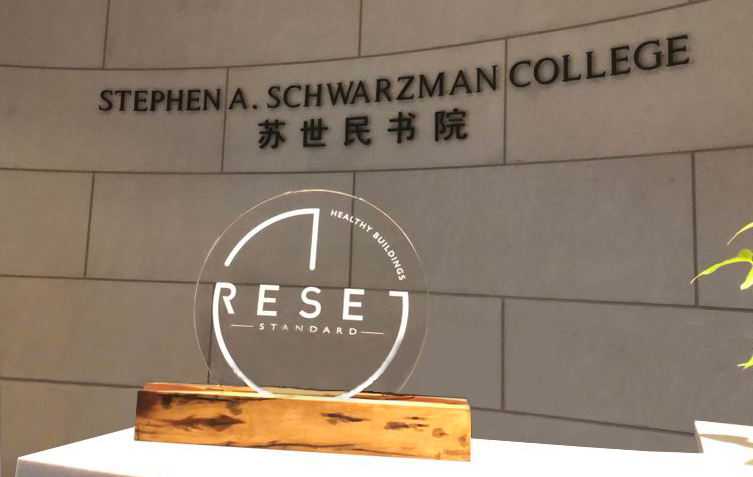
Tsinghua University in Beijing is widely known as one of the most advanced higher-education institutions in the world. Now, thanks to Schwarzman College, the University can add another achievement to its list of accolades: Tsinghua now boasts the world’s first academic building to achieve the RESET™ Air Certification for Commercial Interiors.
The 200,000 square foot structure of Schwarzman College officially received the RESET™ Air Certification for Commercial Interiors in March 2018, after a performance period that began in December of 2017. RESET™ Air is the world’s first sensor-based, performance-driven building certification program, focused specifically on air quality for indoor environments. Data from this enterprise’s performance period also presents a unique opportunity for the design community to gain insight on how such an ambitious project can be completed.
The State of Outdoor Air Pollution in Beijing
Outdoor air quality significantly impacts a building’s indoor atmosphere. In Beijing, outdoor PM2.5 levels were relatively healthy during the project’s data analysis (performance) period, as displayed in graph 1. However, even this relative drop in outdoor particulate matter made achieving excellent indoor PM2.5 levels only marginally easier.
Graph 1: Outdoor PM2.5 during data analysis period.
Data Audit Requirements for RESET™ Air Certification, Commercial Interiors
- Projects must be able to collect and report sufficient data. Projects are not to exceed 20% allowance for missing data.
- Projects must stay within a 10% performance range for all target pollutants during working hours as defined by the project.
- Target pollutants and their respective thresholds are:
- PM2.5 < 35 µg/m3
- CO2 < 1000 ppm
- TVOC < 500 µg/m3
Minimum data collection/reporting and target pollutant thresholds
The minimum data collection requirements and target pollutant thresholds for Schwarzman College during its performance period were reported as follows:
|
Table 1 |
PM2.5 |
CO2 |
TVOC |
|||
|
|
Pollutant Threshold |
Missing Data |
Pollutant Threshold |
Missing Data |
Pollutant Threshold |
Missing Data |
|
December 2017 |
2.3% |
2.3% |
0.0% |
2.3% |
1.6% |
2.3% |
|
January 2018 |
2.3% |
1.2% |
0.0% |
1.2% |
2.3% |
1.2% |
|
February 2018 |
0.9% |
17.4% |
0.0% |
17.4% |
0.7% |
17.4% |
The project met the data reporting/collection and pollutant threshold requirements as outlined in the RESET™ Air for Commercial Interiors Standard during the performance period. This can be attributed to the continuous monitoring and reporting information available at the early phases of the performance period, allowing the project team to adjust and improve data collection from 17% in February to 3.9% in March and 3.3% in April (tables 1 & 2).
RESET™ Air is a performance-driven certification, meaning projects are required to maintain target thresholds as well as minimum data collection for three consecutive months to gain certification.
Despite Beijing’s poor air quality, the Schwarzman College building performed extremely well throughout March and April of 2018, as noted in table 2. The ability to compare outdoor air conditions to indoor air quality on a granular level not only serves as a core component of the RESET™ Air Certification, but also stands as a testament to the building’s ability to deliver clean air to occupants during adverse outdoor air conditions.
|
Table 2 |
PM2.5 |
CO2 |
TVOC |
|||
|
|
Pollutant Threshold |
Missing Data |
Pollutant Threshold |
Missing Data |
Pollutant Threshold |
Missing Data |
|
March 2018 |
7.2% |
3.9% |
0.0% |
3.9% |
2.0% |
3.9% |
|
April 2018 |
2.7% |
3.3% |
0.4% |
3.3% |
3.1% |
3.3% |
Maintaining target pollutant threshold limits for 3 consecutive months
I. PM2.5
The PM2.5 measurements as monitored and reported by the project are compared to Beijing’s outdoor air quality during during the data analysis period in graph 2 below.
Graph 2: The marked disparity between indoor and outdoor PM2.5 levels.
Subsequently, graph 3 highlights that even in times of extremely high outdoor PM2.5 levels (such as March and April), the project maintains excellent indoor PM2.5 levels.
Graph 3: Example of the project’s excellent indoor PM2.5 during high outdoor PM2.5 levels in March 2018
Note: The shaded area shows non-working hour readings, which are not required to be included in calculations towards the RESET™ Air certification.
(Data source: qlear.build)
|
Table 3 – Monthly Average |
Outdoor PM2.5 (µg/m3) |
Indoor PM2.5 (µg/m3) |
|
December 2017 |
43 |
8 |
|
January 2018 |
34 |
8 |
|
February 2018 |
38 |
6 |
II. CO2
CO2 is typically used as a proxy gas, often to approximate the lack of fresh air in a building. Recent studies have pointed to the possible adverse effects of high CO2 levels, particularly on cognitive abilities and productivity of building occupants.
The data audit and analysis of CO2 revealed that the project did not once exceed the allowable limits as defined by RESET™ Air during the 3-month data analysis period, an notable achievement for any project. As detailed in graph 3 below, the CO2 levels consistently remained under 600 ppm—well below the RESET™ Air basic performance requirement of 1000 ppm.
Graph 4: CO2 data during data analysis period
III. TVOC
TVOC measurements are helpful in determining a space’s chemical hygiene. While not a spectated metric, high concentrations of TVOC may point to a larger problem in a building’s overall indoor air quality. Cleaning products, perfumes, air fresheners, candles, incense, and the chemicals present in building materials are all direct contributors to high TVOC levels.
Graph 5 illustrates the Schwarzman College’s TVOC levels, reporting consistently at or below 400 µg/m3. Once again, the project is out-performing the RESET™ Air requirement of 500 µg/m3.
Graph 5: TVOC data during data analysis period
Other noteworthy trends
PM2.5 Protection Factor:
RESET™ Air defines PM2.5 Protection Factor as a building’s ability to protect occupants from outdoor pollution, specifically PM2.5. This quantity is calculated as:
PM2.5 Protection Factor = (
Construction quality and mechanical system design (HVAC) both directly determine a building’s ability to successfully reduce indoor pollutant levels.
|
Table 4 |
PM2.5 (µg/m3) |
|
|
|
|
Schwarzman Indoor |
Oudoor |
PM2.5 Protection Factor |
|
14 March 2018 |
38.8 |
191.0 |
80% |
|
2 April 2018 |
37.1 |
253.9 |
85% |
Table 4 illustrates the worst PM2.5 outdoor air events recorded during the project’s monitoring period—in this case, after the 3-month data analysis period. These peak levels occurred on March 14 and April 2, 2018. When compared to the project’s reported interior PM2.5 levels, the Protection Factors for the two dates are 80% and 85%, respectively.
Graph 6: Period of high outdoor PM2.5 levels
To put the achievements of the Schwarzman College project into perspective, as per our internal study, in most class-A office buildings in Beijing, the average PM2.5 Protection Factor was only a paltry 57%.
Conclusion
Not only has the Schwarzman College building successfully achieved the RESET™ Air Certification for Commercial Interiors, but it has exceeded expectations in delivering healthy indoor air to its occupants. The building’s Protection Factor of 80-85% against outdoor pollution is evidence of its high-quality design and mechanical system. With continuous monitoring in place and annual maintenance and calibration requirements, this project is anticipated to continue providing improved air quality to its occupants.
About RESET
RESET™ is the world’s first sensor-based and performance-driven building standard and certification program. RESET™ prioritizes occupant health and environmental regeneration, starting with material chemistry and indoor air quality (IAQ) through continuous monitoring. A healthy ecology and economy can only be achieved when people are healthy.
For more information, visit: www.reset.build
About Schwarzman Scholars
Schwarzman Scholars was inspired by the Rhodes Scholarship, which was founded in 1902 to promote international understanding and peace, and is designed to meet the challenges of the 21st century and beyond. Blackstone Co-Founder Stephen A. Schwarzman personally contributed over $100 million to the program and is leading a fundraising campaign to raise an additional $500 million from others to endow the program in perpetuity. Schwarzman Scholars has already raised $516 million towards this $600 million goal. The endowment will support up to 200 Scholars annually from the U.S., China and around the world for a one-year Master’s Degree program at Tsinghua University in Beijing. Scholars chosen for this highly selective program have demonstrated exemplary leadership qualities and their potential to bridge and understand cultural and political differences.
Learn more at: www.schwarzmanscholars.org
